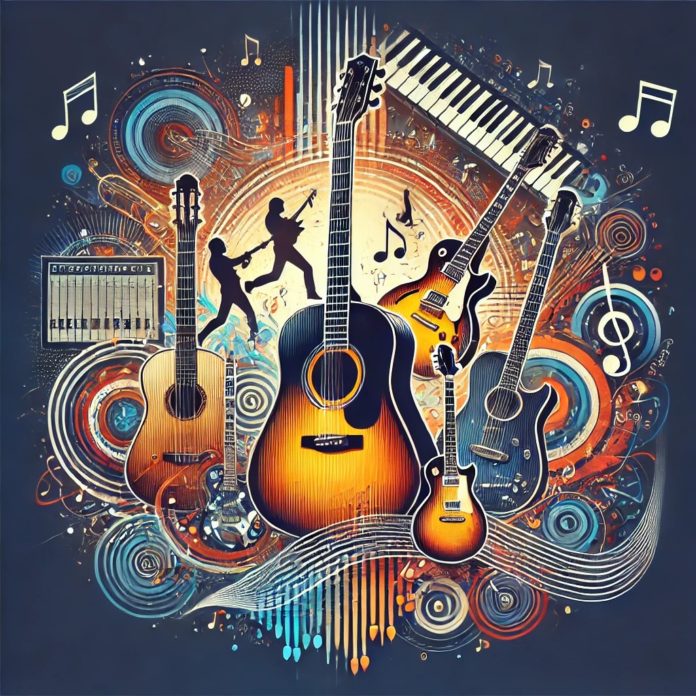For decades, the guitar solo was a defining element of popular music, a moment of pure, unfiltered expression that allowed guitarists to showcase their virtuosity and creativity. But like all trends, the prominence of the guitar solo has ebbed and flowed. Today, we explore the heyday of the guitar solo, its iconic practitioners, its decline, and what the future might hold for this once-dominant feature of music.
When Was the Guitar Solo’s Heyday?
The golden age of the guitar solo can be traced back to the late 1960s through the 1980s. This period saw the electric guitar ascend to the forefront of rock and roll, with solos becoming a staple in songs across genres. The heyday truly began with the British Invasion and the rise of bands like The Beatles and The Rolling Stones, who brought the electric guitar to the masses.
In the 1970s, the guitar solo reached its zenith, with bands like Led Zeppelin, Deep Purple, and Pink Floyd pushing the boundaries of what the instrument could do. The 1980s saw the peak of the guitar solo’s popularity, especially in the world of rock and heavy metal, where guitarists like Eddie Van Halen, Slash, and Yngwie Malmsteen became household names, their solos often serving as the climax of a song.
Iconic Guitarists
The history of the guitar solo is inseparable from the legends who perfected the art. Here are some of the most iconic guitarists whose solos have become the stuff of legend:
- Jimi Hendrix: Perhaps the most influential guitarist of all time, Hendrix’s solos, such as those in “All Along the Watchtower” and “Voodoo Child,” are unmatched in their innovation and emotional depth.
- Jimmy Page: As the lead guitarist of Led Zeppelin, Page crafted some of the most memorable solos in rock history, including the epic “Stairway to Heaven.”
- Eddie Van Halen: Known for his groundbreaking technique, Van Halen’s solo in “Eruption” is a masterclass in speed, precision, and showmanship.
- David Gilmour: The Pink Floyd guitarist’s solo in “Comfortably Numb” is a perfect blend of melody and emotion, often cited as one of the greatest solos of all time.
- Slash: With his top hat and Les Paul guitar, Slash became the face of the 1980s rock guitar, delivering unforgettable solos in songs like “Sweet Child O’ Mine.”
When Did the Guitar Solo Disappear?
The prominence of the guitar solo began to wane in the 1990s with the rise of alternative rock and grunge. Bands like Nirvana and Pearl Jam eschewed the flashy solos of the 1980s in favor of more stripped-down, raw sounds. This shift reflected a broader cultural move away from the excesses of the previous decade, with a focus on authenticity and simplicity.
By the 2000s, the guitar solo had largely faded from mainstream pop music, with the rise of electronic music, hip-hop, and other genres that prioritized beats, production, and vocals over instrumental prowess. While guitar solos never entirely disappeared, they became less common in the charts and less central to the identity of popular music.
Who Killed the Guitar Solo?
The decline of the guitar solo cannot be attributed to a single person or event. Rather, it was the result of several factors converging over time:
- Changing Musical Tastes: As listeners gravitated towards genres like hip-hop, electronic music, and pop, which emphasize rhythm and production over instrumental solos, the guitar solo naturally fell out of favor.
- Cultural Shifts: The 1990s brought a backlash against the perceived excesses of the 1980s. The grunge movement, in particular, prized authenticity and raw emotion over technical skill, leading to simpler, more direct guitar work.
- Technological Advances: The rise of digital production tools and the increasing use of synthesizers and drum machines in pop music also contributed to the guitar solo’s decline. These new tools allowed artists to explore different sounds and textures, often without the need for a guitar.
The Future of Guitar and the Guitar Solo in Pop Music
So, where does the guitar solo go from here? While it may no longer dominate the airwaves, there are signs that it is far from dead.
1. A Niche Renaissance: In recent years, there has been a resurgence of interest in guitar-driven music, particularly in the indie and alternative scenes. Bands like The War on Drugs, Tame Impala, and John Mayer are keeping the spirit of the guitar solo alive, albeit in a more subdued and introspective form.
2. AI and the Evolution of the Solo: The future of the guitar solo may also lie in the integration of technology. AI and machine learning are beginning to influence music production, with algorithms capable of generating music, including guitar solos. While purists may balk at the idea, AI could offer new possibilities for creativity, allowing musicians to explore new sounds and techniques.
3. The Guitar as a Symbol: Even if the guitar solo never regains its former prominence, the guitar itself remains a powerful symbol in music. It represents a connection to the past, to the golden age of rock and roll, and to the idea of music as a deeply personal, human endeavor.
The Guitar Solo’s Enduring Legacy
The guitar solo may no longer be the centerpiece of popular music, but its legacy endures. It represents a time when music was about more than just the notes—it was about pushing boundaries, expressing emotion, and connecting with an audience on a visceral level. As music continues to evolve, the guitar solo will likely remain a cherished part of its history, even as new forms of expression take its place. And who knows? With the right artist and the right song, the guitar solo could make a triumphant return to the spotlight.







